
Berberis aquifolium, the Oregon grape or holly-leaved barberry, is a species of flowering plant in the family Berberidaceae, native to western North America. It is an evergreen shrub growing 1–3 meters tall and 1.5 m (5 ft) wide, with pinnate leaves consisting of spiny leaflets, and dense clusters of yellow flowers in early spring, followed by dark bluish-black berries.

Mahonia is a formerly accepted genus of approximately 70 species of shrubs or, rarely, small trees with evergreen leaves in the family Berberidaceae, native to eastern Asia, the Himalaya, North America, and Central America. They are closely related to the genus Berberis and as of 2023 the majority of botanical sources list it as a synonym for Berberis.

Berberis, commonly known as barberry, is a large genus of deciduous and evergreen shrubs from 1–5 m (3.3–16.4 ft) tall, found throughout temperate and subtropical regions of the world. Species diversity is greatest in South America and Asia; Europe, Africa and North America have native species as well. The best-known Berberis species is the European barberry, Berberis vulgaris, which is common in Europe, North Africa, the Middle East, and central Asia, and has been widely introduced in North America. Many of the species have spines on the shoots and all along the margins of the leaves.
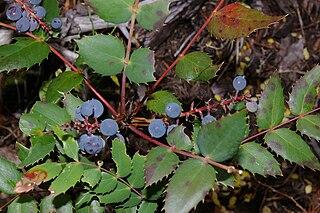
Berberis nervosa, commonly known as dwarf Oregon-grape, Cascade barberry, Cascade Oregon-grape, or dull Oregon-grape, is a flowering plant native to the northwest coast of North America from southern British Columbia south to central California, with an isolated population inland in northern Idaho. It is especially common in second growth, Douglas-fir or western redcedar forests, making use of those pools of sunlight that intermittently reach the ground.
Berberis piperiana is a shrub native to the mountains of northern California and southwestern Oregon. It is found in open and wooded slopes at elevations of 900–1,700 m (3,000–5,600 ft).

Berberis fortunei is a species of shrub in the family Berberidaceae, the barberry family, described in 1846. It is endemic to China, found in the provinces of Chongqing, Guangxi, Guizhou, Hubei, Hunan, Jiangxi, Sichuan, Taiwan, and Zhejiang. It is grown as an ornamental in many lands, with common names including Chinese mahonia, Fortune's mahonia, and holly grape.
Berberis moranensis is a shrub in the genus Berberis in the family Berberidaceae. Because of its compound leaves, some botanists place it in the genus Mahonia. It is native to forested regions of the mountains of Mexico from Sinaloa and Guanajuato to Oaxaca. Berberis moranensis has thick waxy leaves, yellow flowers, and purple berries. This species is closely related to Berberis pimanaJ.E. Laferr. & J.S. Marr.
Berberis chochoco is an evergreen shrub or small tree up to 9 m (30 ft) tall, in the genus Berberis, family Berberidaceae. It is native to mountainous regions of northeastern Mexico, in the states of Nuevo León, Veracruz, and San Luis Potosí.

Yepáchic, sometimes spelled Yepáchi, is a community in the western part of the Mexican State of Chihuahua, approximately 10 km (6.2 mi) east of the boundary with the State of Sonora. It is located in the Municipio de Temósachic at an altitude of 1,780 meters (5,840 ft) in the Sierra Madre Occidental. Many of the people of the region are members of the indigenous ethnic group called Mountain Pima or the Pima Bajo. They are related to the Pima and Papago of Arizona and northern Sonora, speaking a similar but distinct language.
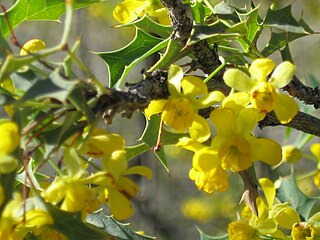
Berberis harrisoniana is a rare species of flowering plant in the barberry family, Berberidaceae. It is known by the common names Kofa barberry, Kofa Mountain barberry, Harrison's barberry, and red barberry.
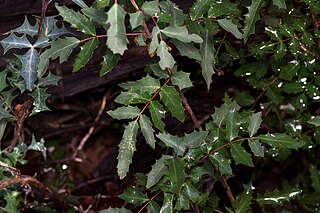
Berberis swaseyi is a rare species of barberry endemic to the Edwards Plateau region of Texas. It grows in limestone ridges and canyons. The species is evergreen, with thick, rigid, five-to-nine foliolate leaves. Berries are dry or juicy, white to red, about 9–16 mm in diam.

Berberis haematocarpa, Woot. with the common names red barberry, red Mexican barbery, Colorado barberry and Mexican barberry, is a species in the Barberry family in southwestern North America. It is also sometimes called algerita, but that name is more often applied to its relative, Mahonia trifoliolata.
Berberis wilcoxii is a shrub native to Arizona, New Mexico and Sonora. It is up to 2 m tall, with pinnately compound leaves of 5-7 leaflets, densely clustered racemes and ovoid berries up to 10 mm long. It is generally found in rocky canyons in mountainous areas at an elevation of 1700–2500 m.
Berberis muelleri is a shrub with compound leaves, native to the Mexican State of Nuevo León.
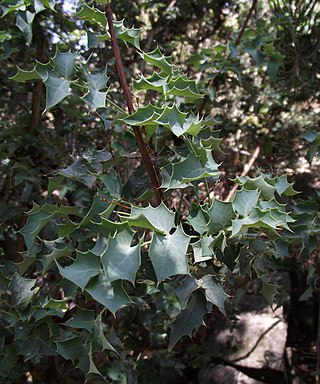
Berberis higginsiae is a shrub found only in a small region south and east of San Diego in southern California and northern Baja California. It grows in chaparral and woodland areas at elevations of 800–1,200 m (2,600–3,900 ft).
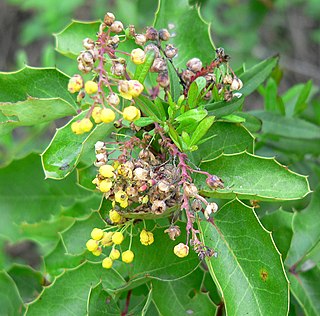
Berberis amplectens is a rare species of shrubs endemic to the Peninsular Ranges of southern California, east of San Diego.

Berberis pumila is a species of shrub native to Oregon and northern California. It is found in open woods and rocky areas at an altitude of 300–1,200 m (980–3,940 ft) in the Coast Ranges, the northern Sierra Nevada and the southern Cascades, often on serpentine soils.

Berberis gracilis is a plant species native to the Mexico, widely distributed from Tamaulipas to Oaxaca.
Joseph Edward Laferrière is an American botanist with a particular interest in ethnobotany.
Berberis incerta is a shrub described as a species in 1901. It is endemic to eastern Mexico, known from the States of Hidalgo and Veracruz.












